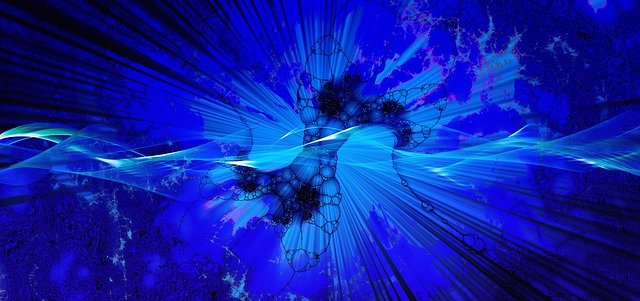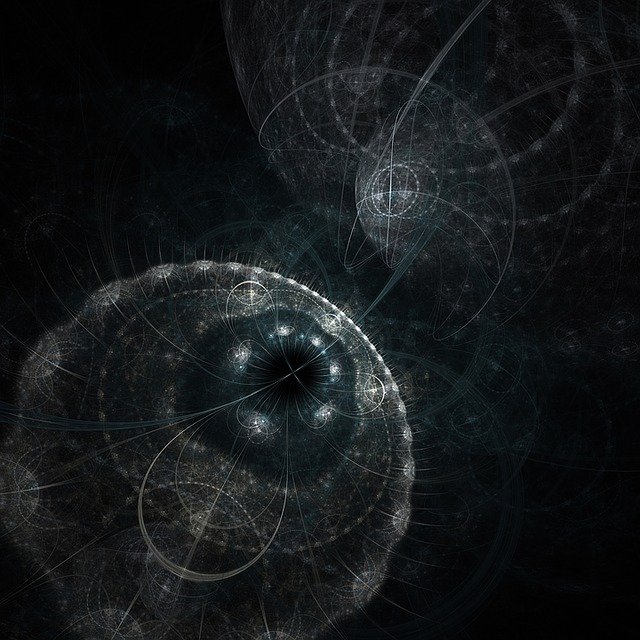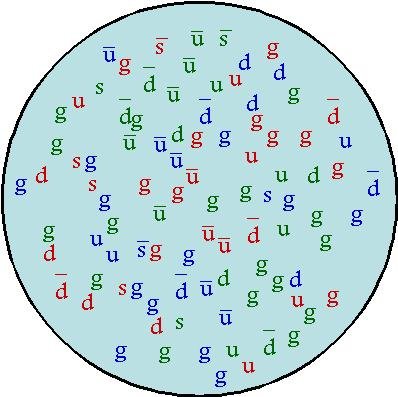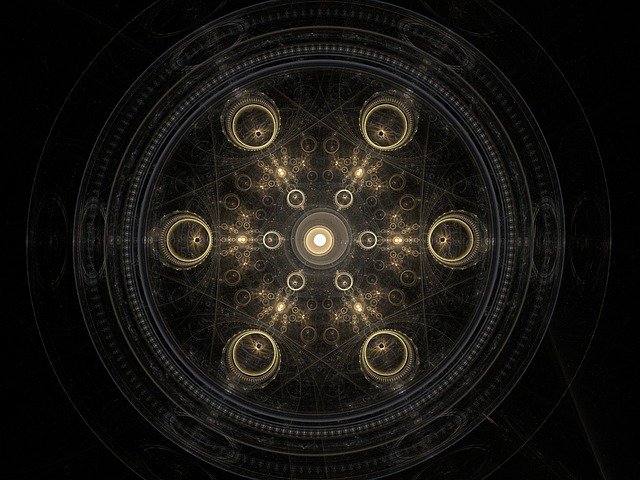Journey through the understanding of particle physics - Two bis
This article provides corrections and annotations for various mistakes present in my previous post Journey through the understanding of particle physics - Two.
I prefer leaving the original text in the post and indicate where corrections were made as I think other people might recognise some of the misconceptions they would have had like me about the difficult subject of particle physics.
All corrections and annotations are shown in bold fonts. Statements that are simply untrue are stroked through.

[image credits - PixaBay]
This is the second post in my series about my journey in trying to understand the world of particle physics through my reading of other posts on Steemit and online research.
In my previous post I described what I had learn with regards to certain particles and some of their properties when measured by the LHC detector such as pseudorapidity and transverse momentum.
The particles discussed were electrons, muons, photons and jets.
This is only a subset of known particles.
Correction: jets are not particles but complex objects made of particles which interact, radiate and decay into other particles.
Particles are divided into two main groups: fermions and bosons.
Fermions
Fermions are particles with mass and therefore can have a momentum (think "inertia" in classical physics) and constitute all the matter around us that you can touch.
Correction: massless fermions also exist so it is wrong to assume that fermions necessarily correspond to matter around us. Fermions can be elementary (e.g. electrons) or composite (e.g. protons). From what I understand the main difference between fermions and bosons is that they differ in their spin. Fermions have half integer spins (..., -3/2, -1/2, 1/2, 3/2, ...) while bosons have integer spin values (..., -2, -1, 0, 1, 2, ...).
Fermions include particles such as quarks, electrons and muons.
Fermions obey the Pauli exclusion principle which states that no 2 fermions of the same type can be in the exact same states at any given time. For example this implies that two electrons sharing the same spin cannot share the same orbital level in an atom. As electrons can only have 2 spin values (1/2 and -1/2) this limits the number of electrons per orbital to 2.
Fermions then to clutter together into "lumps" of mass but for this they need the contribution of bosons.
Bosons
Bosons are carrier particles which don't have mass (and therefore travel at the speed of light). They are qualified as carrier particle because these particles carry the different forces of nature: electromagnetic force, weak nuclear force, strong nuclear force and gravity.
Correction: the above is not entirely correct. Some bosons have mass and ll bosons are not force carrier, only a subset of them. Like fermions, bosons can be elementary (e.g. photons and gluons) or composite (e.g. muons ). As mentioned above bosons have integer spin values. They do not obey the Pauly exclusion principle.
Each force is the result of a specific type of boson being exchanged between fermions which can interact with this boson.
Note: This is one way to look at how a force interact on particles. However there is a second interpretation which imagine forces mediated through the fields (force fields).
Bosons cause attraction or repulsion between particles which can interact with them. You can think about it as particles travelling at the speed of light. When they meet a compatible fermion, the either "pull" the fermion in the direction it came from, or "push" the fermion in its own direction of travel. This may be inaccurate but it is how I visualize this.
Note: Indeed the above description of forces, which was my understanding at the time of the writing, appears to be very approximate. What I have been missing here is some understanding of quantum field theory and the nature of what we perceive as particles.
Again it should be noted that only certain bosons are force carriers.
In quantum field theory every particle is the manifestation of the excitation (quanta of energy) supplied to their corresponding field.
The theory predicts that what we perceive as the motion of a particle through space corresponds in reality to the motion of of this excitation through the associated field.
Now, forces of nature seem to be the result of similar perturbation in the fields which are transient (don't last forever) and take the form of virtual particles. For example, electric charges attract or repel each other through the exchange of virtual photons. So far it's not obvious to me where these virtual particles come from, though I read somewhere that these appear out of nowhere (the vacuum)... To be confirmed.
Quantum field theory is a vast subject and I think I may have to understand a bit better the ideas behind it before moving on to other topics.
For example, photons are the bosons carrying the force of electromagnetism causing the negatively charged side of a magnet to attract the positively charged side of another magnet.
I assume here that there are different types of photons since I'm not sure those photons emit any kind of light (visible or not). I could be wrong about this.
Note: I now understand that virtual photons are responsible for the force of electromagnetism (see above), though I'm not sure about the difference between virtual photons and those emitted by a light source.
Another example are gluons. Gluons can interact with quarks and pull them together. Without gluons the universe would be a sea of quarks and no atom could be formed.

[Image credits - Pixabay]
Now, one thing that I do not understand yet is how bosons are created. I assume that for a force to be constant between fermions a constant production of bosons must also exist and exchanged between those fermions.
So this raises 2 important questions for me:
~~1. Where are bosons created? Inside fermions?
- If bosons are consumed when they interact with another particle, what is causing the endless supply of bosons?
- Forces like gravity operate in all directions with the same properties (strength). How is this compatible with the discrete number of bosons?~~
Note: I think all of the above questions can be ignored for now as they result of a lack of understanding of quantum field theory. I hope to be able to have better answers after more study on the subject.
Structure of the proton
As its name suggests the LHC generates collisions between hadrons which are energetic enough to rip apart the internal structure of these particles and cause sub-elements to break free and sometimes interact with each other or the LHC sub-detectors.
The LHC detector (there is in reality a couple of distinct detectors: Atlas, CMS, Alice, etc) is in reality a clever assembly of of sub-detectors made of different materials (e.g. silicon, lead, etc).
Each sub-detector is capable of detecting certain particles because those particles can interact with the material of that detector which result in electric signals that can be interpreted by scientists
Hadrons refer to composite particles made of quarks held together by one of the four forces of nature: the strong nuclear force.
Most known hadrons include protons (positively charged) and neutrons (electrically neutral). Indeed many experiments taking place in the LHC involve the repeated collision of protons.
Now I always wondered why so many particles where detected following the collision of two protons since I learned at school and through various media that a proton is made of 3 quarks: 2 up quarks and 1 down quark.
This is not correct.
In reality each proton is made of a very large amount of many types of quarks, anti-quarks and gluons.

[Image credits - Matt Strassler]
The internals of a proton is a real mess of many, many particles moving at frantic pace (close to the speed of light) in all directions, only held together by the gluons which carry the massive strong nuclear force.
But it turns out that all these sub-particles almost balance each other. For example, there are as many top quarks as anti top-quarks.
However there is just an imbalance of 2 up quarks (versus anti up-quarks) and 1 down quark (versus anti down-quarks).
When two protons are collided with enough energy (opposite velocity), the nuclear force is not enough to keep the structure intact and many of the proton constituents are propelled against each other and in all directions.
This causes some particles to react with each other and turn into other particles.
In all this chaos, certain properties of the system are preserved, while other properties are not preserved.
As an example of preserved property, the total angular momentum of all produced particles always match the total angular moments of the hadrons (and all their constituent) before the collision.
On the other hand, the total mass of the particles involved before and after the collision is rarely preserved. Instead some of the original mass is converted into energy (E=mc^2) and vis versa.
Correction: The above E=mc^2 equation above is not correct because it only describes the relationship between a particle energy and its mass at rest (not moving). In reality particles moving at relativistic speeds get an energy contribution linked to their momentum.
On way to see that E=mc^2 is incorrect for a particle in motion is that, if this was the case, particles without mass at rest such as the photon would have no energy, which is clearly not the case.
The Standard Model
The Standard Model is the physics theory describing the weak nuclear force, the strong nuclear force and the electromagnetic force and their interactions with fermions.
The standard model has proved to be extremely accurate over decades of scientific experiments. Mathematical predictions have never failed to be in line with experimentation and it is therefore logical to think that this model cannot be entirely wrong.
However the standard model falls short to explain all physical laws of nature.
Most notably the standard model does not describe the laws of gravity: the general relativity.
It also cannot describe the huge discrepancy between the weak nuclear force and gravity (4x10^29^!) referred to by physicists as the hierarchy problem.
Recent astronomical measurements have also suggested that the universe is significantly more massive than previously thought, raising the possibility of a new type of matter name Dark Matter.
The shortcomings of the Standard Model have caused many physicists to go on a quest to find a new theory that would explain all of the above issues.
That new theory would have to be compliant with previous experimentation. As such it would be viewed as a more complete theory of nature than the Standard Model, similar to how General Relativity relates to the Newtonian laws of motion and attraction.
One such theory is Supersymmetry
Supersymmetry
Supersymmetry is one of the leading, but yet unverified, theories to fill some of the gaps left by the standard model.
Note: Supersymmetry doesn't answer all questions left unanswered by the Standard Model.
As its name suggests it also brings in a certain beauty in people minds because it brings in an element of symmetry at the heart of nature.

[Image credits - Pixabay]
At its core Supersymmetry predicts that every known particle has a counterpart, a "superpartner".
For example an electron would have a superpartner called "selectron", a quark would have a superpartner called a "squark", and so on.
Each particle and its superpartner would have all the same properties (mass, charge, etc) but one: their spin would differ by 1/2.
Correction: Superpartners are expected to have a higher mass than their known particle equivalents. Also, fermion superpartners would be bosons, while boson superpartners would be fermions.
The spin is one of the fundamental properties of particles which is similar to angular momentum in classical physics. It has many resemblance with the concept of an object spinning around its axis such as a planet or a spinning top.
However there are several differences.
For example, the spin of particles can only take certain fixed values, while macroscopic objects can take any value.
The problem with Supersymmetry is that no superpartner particle has ever been detected in the LHC.
From what I understand it is now believed by many scientists that, if the theory is correct, superpartner particles may be much more massive than known particles.
The energy limitation of LHC makes it difficult for now to detect those particles though it looks like a future run of the accelerator may yield to results in that field.
Research paper used for @lemouth's exercise
Let's now get back to @lemouth research paper which is at the center of his recent exercises
Let's review the title:
Search for top-squark pair production in final states with one lepton, jets, and missing transverse momentum using 36 fb−1 of √ s = 13 TeV p p collision data with the ATLAS detector
So, I haven't delve any deeper into the paper since my last post due to a lack of time but at least I understand that the paper is describing the hunt for the discovery of a top-quark superpartner, the top-squark.
With this in mind I will now focus on improving my own understanding of Supersymmetry and how this relates to the above research paper and @lemouth programming exercises.
Conclusions on the review of this post
From the above notes and corrections you can see that my understanding of particle physics still leaves a lot to desire. :-)
I feel now that I would gain a lot by improving my understanding of quantum field theory and the relationship between mass and energy.
It is also clear that I must leave behind my preconceptions about the nature of reality, such as particles being corpuscules. In some cases the theories can lead to different visualisations.
References
- Of Particular Significance - Conversations About Science with Theoretical Physicist Matt Strassler
- About my own research: gluons, gluinos and sgluons are not weird creatures from Harry Potter by @lemouth
- Supersymmetry on Wikipedia
Other posts in this series
- https://steemit.com/utopian-io/@irelandscape/journey-through-the-understanding-of-particle-physics-one
- Pauli Exclusion Principle on Wikipedia
- Spin on Wikipedia
- Standard Model on Wikipedia
STOPCongratulations! Your post has been selected as a daily Steemit truffle! It is listed on rank 14 of all contributions awarded today. You can find the TOP DAILY TRUFFLE PICKS HERE.
I upvoted your contribution because to my mind your post is at least 17 SBD worth and should receive 121 votes. It's now up to the lovely Steemit community to make this come true.
I am
TrufflePig, an Artificial Intelligence Bot that helps minnows and content curators using Machine Learning. If you are curious how I select content, you can find an explanation here!Have a nice day and sincerely yours,

TrufflePigYou may like this old post of mine as well as this one. I wrote them 9 months ago, but they may be appropriate in terms of what you are looking for and the level of simplification. Please let me know :)
Thanks these are great resources.
I am currently reading a good bit to try to prepare a future post about my understanding of mass, energy and the current interpretation of quantum field theory.
Your posts are very relevant.
I am designing slides on the basics (undergrad level). I could share them if interested ;)
Definitely, that'd be great. 😀
Noted. I need to finish them first. I lecture in 8 days... so... they will be done soon :D
No pressure. You are the one on a deadline now. 😉
Closer and closer :(
Hi @irelandscape!
Your post was upvoted by utopian.io in cooperation with steemstem - supporting knowledge, innovation and technological advancement on the Steem Blockchain.
Contribute to Open Source with utopian.io
Learn how to contribute on our website and join the new open source economy.
Want to chat? Join the Utopian Community on Discord https://discord.gg/h52nFrV